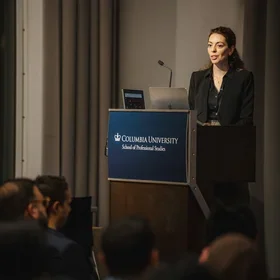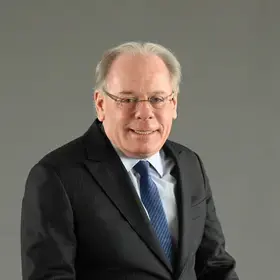How do you drive innovation capacity in an organization? What are the interventions, risks, and pitfalls?
By Illana Raia
During the Information and Knowledge Strategy (IKNS) program residency at Columbia University, a panel of speakers representing Nike, World Bank, Wells Fargo, Educational Testing Service, Valora Technologies, and Thomson Reuters convened to answer these questions. Illana Raia, IKNS guest faculty member and former Knowledge Counsel for Skadden, Arps, served as moderator.
1. Set Your Mark
As Carlos Gámez of Thomson Reuters explained, determining how your company plans to measure innovation involves several steps:
-
First, “you need an innovation strategy – a hypothesis that answers how encouraging and funding certain activities could accelerate business results.”
-
Next, you need real metrics to validate your hypothesis, project by project. “[Metrics] help you learn and place more follow-on bets…you are buying options with this new information,” said Gámez.
-
Panelists concurred that it’s not enough to measure the return on investment without having a sort of rubric for evaluating successful/unsuccessful experiments, disruptive/incremental impacts on the industry, and disruptive/incremental impacts on an organization.
-
“The bottom line is this: it ultimately has to be what the market wants,” said Nathan Bricklin of Wells Fargo.
2. Have an Innovation Mindset
World Bank’s Kelly Widelska and Nike consultant Julie Langford agreed, noted that numerous innovation roles – whether agitator, coach, evangelist, or project manager – require a mindset of thinking outside the box. Certainly, we can nudge, train, and encourage employees to push boundaries and seek creative solutions, but most panelists argued also for an infusion of talent uninhibited by company tradition, functional norms, or industry norms. An innovative culture begins with hiring. “Look for candidates with deep curiosity,” urged Kelli Carlson of Wells Fargo. “To create the right environment, we need lots of that.”
3. Build an Ecology of Risk Tolerance
Once you have established parameters for how you will measure innovation, the next step is inviting a wide swath of creative thinkers and risk takers within your community and placing what Gámez called “bets” on them. Panelists shared their strategies for this:
-
Applaud publicly those who take risk.
-
Simultaneously create a safe environment in which to fail.
-
Extract the wisdom hidden in those failures and broadcast that.
Wells Fargo’s Kelli Carlson advised to “fail fast” but “feel the pain” in order to glean insight from experience. “Failure is the foundation of learning and a far better teacher than success,” added former ETS Chief Learning Officer T.J. Elliott, paraphrasing Bill Gates.
Panelists agreed that what we shouldn’t do is to isolate failures as deviant, and not part of the innovation process. They stressed the importance of seeing the whole picture rather than focusing on a single failure.

4. Bridge and Cross-Pollinate
Innovation often comes from bridging ideas from one domain or application to the next. “Collaborate across your corporate cultures even when it seems impossible,” stated World Bank’s Kelly Widelska, “We have academics co-design with investment bankers.”
“Multiple functions need to collaborate,” agreed Wells Fargo’s Kelli Carlson, “to get the ideas that can survive in the wild.” How different organizations achieve this depends largely on corporate culture. Striving for an “empathy culture” — being open-minded even when it feels risky — was a common goal.
“Agitators get attention,” warned Wells Fargo’s Nathan Bricklin, noting that creative input should be sought from all members of a team. He added that, as a manager, you also need to be able to hear those reticent to speak. “You have to be multispeed, fast and slow.” Not all innovations will come in blaze of galloping horses. Some will come slowly, such as in the gnawing realization that a meeting went badly.
5. Do the Unexpected
From bite-sized daily innovation texts to full-scale accelerator programs, the panelists shared how they engage their communities in thoughtful and provocative ways, including gamification, hackathons, product design contests, and innovation jams.
Kelli Carlson described her “daily innovation texts” about the innovation process and high-profile innovations in the industry. She and Nathan Bricklin also described the “Appy Hour,” a monthly (alcohol-free) gathering among the Wells Fargo Innovation Group where “we choose anywhere from 3 to 5 apps, identify their applicability to our group, and then demo them for an hour.”
6. Respect the Past – It Could be Your Future
Finally, panelists urged respectful examination of the past. “Don’t lose the tacit knowledge and experience that made you successful in the first place,” admonished ETS’ T.J. Elliott. He pointed out that balancing innovation with the necessary “operating and maintaining” of a company is a subtle distinction for new innovation leaders. The panelists offered some valuable final tips on how to achieve that balance:
-
Be systematic about what you know.
-
Try, fail, learn, and repeat.
-
Revisit and respect prior attempts (whether you call them failures or not), instead of creating new solutions out of whole cloth.
Valora’s Sandy Serkes pointed out that sometimes reviewing the past can be innovative in itself. “We use different circuits in our brain when we consider something in a new light.”


